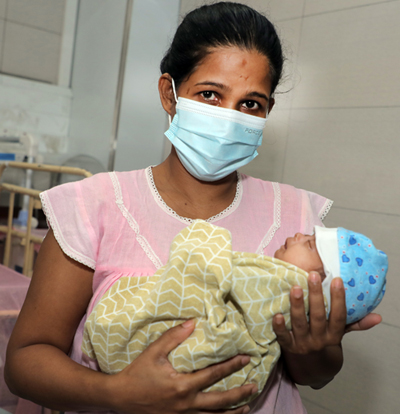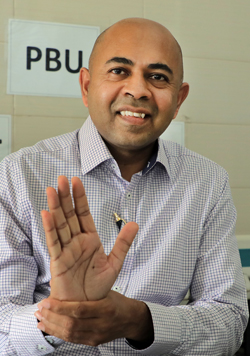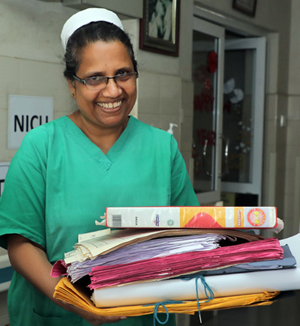After four months of nurturing at DMH little Hithesh is home bound

Her miracle baby: Swarnalatha cuddles her little one. Pix by M.A. Pushpa Kumara
The odds were stacked sky-high against him, but they were not ready to give up.
From the moment he saw the light of day, much too early for his immature body, the battle was on at the premier De Soysa Hospital for Women (commonly called DMH) down Kynsey Road in Colombo to save Hithesh Sasanga.
A life-and-death battle which has lasted four months, up to today! Now, this smallest pre-term baby to be nurtured at the DMH is ready to go home.
As the countdown begins to send Hithesh home as soon as he reaches 1,500g, all tests including a brain scan are proof that he is fine, good news amidst much gloom and doom about severe medicine shortages in the state health sector and doctors leaving the country in droves.
It was a very late pregnancy for 45-year-old E.G. Swarnalatha from Ranjurawa in Ginigathhena, in the Central Province. Her wedding was in February 2022 and as the year drew to a close, she was expecting her first baby, who would also most probably be her one and only baby due to her age.
By December 2022 though the first signs of the pregnancy being in trouble came to the fore and she was in and out of the Karawanella Hospital with ominous cautioning by the doctors that “baba hedila madi” (baby has not developed enough).
With the danger of a miscarriage imminent, Swarnalatha was transferred to the DMH, well-known for its care of difficult premature births. It was February 28, this year.
The Caesarian-section was on March 3 after the doctors had gently made distraught and devastated Swarnalatha aware that her baby was tiny and weak. She saw her baby only the next day, March 4, around 11 a.m.
“Echchara chooty babek jeevitheta dekala thibbe nae (I had never seen such a tiny baby in my life),” she says, reliving the heart-wrenching sight of her son whose hands were like “paen bata” (pen tubes).

Dr. Nalin Gamaathige
He was 28 weeks and weighed less than 500 grams (g), just 468g. He was in DMH’s Neonatal Intensive Care Unit (NICU), with all sorts of tubes snaking from his body to machines.
From the moment Hithesh was taken out of the comfort of his mother’s womb due to unavoidable circumstances, he was under the care of Consultant Neonatologist Dr. Nalin Gamaathige and his caring team of doctors and nurses for whom days and nights did not count in their mission to give a fighting chance to any child, even the most teeny-weeny one.
It is Dr. Gamaathige who explains all about weight and survival of newborns. Usually, a baby is born at 40 weeks and the ideal weight should be 2,500g or more. Those who are born less than 37 weeks in the womb are known as ‘pre-term’ babies and those born with a birth weight less than 2,500g have a ‘low’ birth weight.
“Around 10% of babies born each year are pre-term babies,” he says, pointing out that in Sri Lanka there are around 325,000 live births per year and as such 10% or 32,000 to 35,000 babies would be pre-term.
Pre-term babies, according to their weight, fall into different groups – ‘very low’ if they are below 1,500g; ‘extremely low’ if they are below 1,000g; and ‘extremely rare and low’ if they are less than 500g.
Hithesh was in the high-risk third grouping and Dr. Gamaathige says that such babies do not survive, for the infection rates are a spectre that cannot be dealt with. The challenges were many and the easy option would have been to let go.
Paying tribute to his team, he says they not only did their duty but also went that extra mile to save Hithesh, “less than my palm in size” and so “precious” to his parents.
As we capture photos of the little one, the nursing team’s dedication is obvious in the way they handle the other teeny-weeny ones as well.

Head Nurse Champika with all the paperwork on Hithesh
“The baby was very small and all his organs, the lungs, heart, brain and liver, and also his tummy were not developed. He was critically ill. We immediately attached him to the ventilator to help him breathe,” says Dr. Gamaathige.
But it was not an easy task – it was impossible to find his veins to cannulate him to provide nutrition and antibiotics to ward off infections and the doctors did a “brilliant” job by inserting a line down the baby’s umbilical cord for parenteral nutrition. This was while surfactant to aid lung development was sent through the endotracheal tube.
This Neonatologist says that due to the baby’s stomach not being developed, even through parenteral nutrition which supplies liquid nutrients they could give only amino acids and glucose. But the baby needed proteins, fats, vitamins, minerals and electrolytes especially for brain development.
Knowing the unquestionable importance of breast milk, within 2-3 days of the baby’s birth, the team had got Swarnalatha to express milk and firstly just wetted his lips and mouth with drops as small as 0.5ml. Later breast milk had been introduced speedily through a nasogastric tube (NG tube) to meet the nutrition deficiency of parenteral nutrition.
Another major hurdle was simulating the conditions of the womb, according to Dr. Gamaathige, for which they needed a sophisticated incubator which they did not have.
In stepped the de Soysa family, the descendants of the generous donor who had in fact gifted the land for the DMH, to provide it along with the monitoring equipment vital for such a vulnerable baby.
The team also could not touch the baby for fear of infection, so there had to be minimal handling. “We had to trust and rely on the machines,” says Dr. Gamaathige.
In two weeks, the line down the umbilical cord had been removed for risk of infection, after which a percutaneously inserted central catheter (PICC), a long, very thin, soft flexible tube, had been inserted into a small blood vessel reaching the heart.
“This is the lifeline which we kept for a month,” says Dr. Gamaathige, adding that the baby was kept on the ventilator until he was 33 weeks and then on CPAP (Continuous Positive Airway Pressure), a machine that uses mild air pressure to keep breathing airways open and prevent his lungs from collapsing.
New challenges cropped up too – lower limb fractures due to lack of proper nutrition due to his stomach issues which led to the baby’s legs having to be held up in traction.
Dr. Gamaathige’s simple explanation for this living miracle is proper equipment such as an incubator and seamless team work by the doctors, nurses and minor staff.
The NICU medical team comprises Senior Registrars (SRs) Dr. Indika Prasad & Dr. S. Niththiyaruban and Senior House Officers (SHOs) Dr. G.S.I. Ramawickrama, Dr. R. Ramanayaka, Dr. H. Rajapaksha, Dr. W.A.R. Madurika, Dr. A.S.W. Fernando, Dr. M.J.S. Arachchi, Dr. B. Thagsana & Dr. J.D. Pathirana. The nursing team includes Nursing Officer (NO) H.H.I. Champika (Head Nurse), NO C.M.P. Abeywardana & NO N.G.D.K. Nawarathna.
His heartfelt appreciation also goes out to the de Soysa family, the Colombo West Inner-Wheel Club, the Little Lives Facebook group, corporates such as People’s Leasing and numerous individuals for their immense support.
For Swarnalatha whose tears changed into smiles as she held Hithesh close for the first time on April 24, the belief is: “Pinthura walata udey havah mal thiyanne nethuwa, mae devi-warunta thama isthuthi karanna oney”……..without offering flowers morning and evening to pictures, these are the gods (the DMH team) we need to thank.
Searching for an ideal partner? Find your soul mate on Hitad.lk, Sri Lanka's favourite marriage proposals page. With Hitad.lk matrimonial advertisements you have access to thousands of ads from potential suitors who are looking for someone just like you.


